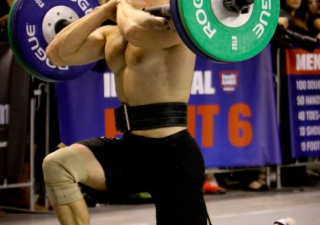I’ve had a lot of people ask me about my preparation for the 2013 Australian CrossFit Regionals. I thought I’d answer their questions with a blog on the training process I went through to qualify.
The aim was always to qualify for Regionals. I never for a moment considered myself an automatic qualification. All training was completed with the target of peaking for The CrossFit Open.
It’s important for me to have everything pre-prepared. It allows me to focus on the training. By working backwards in my planning from an intended peak, I’m able to devise a plan that I know will work. It takes the guesswork out of my training. I simply need to do what I’ve set myself and the outcome will take care of itself.
Along this journey (and the six years I’ve been CrossFitting and coaching) I’ve refined my programming and have packaged it into a complete piece of individualised Fitness Profiling and programming software, My FItness File.


In this blog, I cover:
- Program overview.
- Pre- CrossFit Open.
- During CrossFit Open.
- Pre- Regionals Release.
- Post Regionals Release.
- Session Types Used in the Program.
- Taper.
- Description of Session Types.
- Packaging of the Program – My Fitness File.
PROGRAM OVERVIEW:
The overall concept of the periodisation is that of ‘accumulation’. I began by biasing towards one element of fitness (eg: strength), then retain that as I build another on top of it, then retain that as I build another on top of it. The key is in keeping the stimulus high enough in the ‘already biased towards components of fitness’ to retain the improvement you gained in them while you bias towards something else.
Whenever I biased away from a focus (ie: less heavy powerlifts), the program that replaces them had to be sufficient to maintain the gains made by the biasing – preservation of previously established physical abilities even after they are no longer biased towards.
Once I had my structure in place, my training came down to two very important things:
- Consistency: Precise and unwavering commitment to the program.
- Intensity: Maximum effort in all training.
PRE- CROSSFIT OPEN:
This was the broad plan from seven months out:

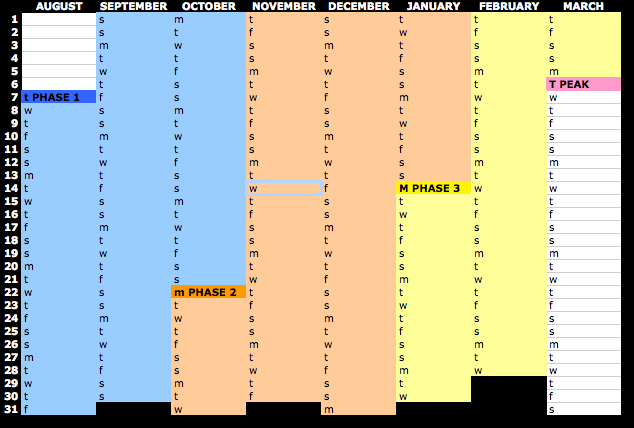
The different phases of training were defined by different session types and different frequencies. The sessions were cycled acording to A Programming Template to Increase Training Volume While Minimising Overtraining.
PHASE 1 (to be completed within seven days):

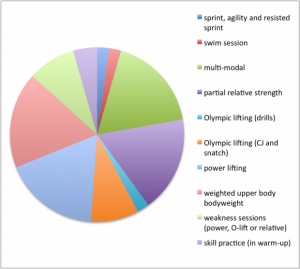
SESSION 1:
A) Power lifting
B) Weighted upper body relative pull
C) Partial relative strength pull
SESSION 2:
A) Weakness
B) Multi-modal
SESSION 3:
A) Power lifting
B) Weighted upper body relative push
C) Partial relative strength push
SESSION 4:
A) Weakness
B) Multi-modal
SESSION 5:
A) Olympic lifting (clean and jerk and snatch).
SESSION 6:
A) Power lifting
B) Weighted upper body relative pull
C) Partial relative strength pull
SESSION 7:
A) Olympic Lifting Drills
B) Multi-modal
SESSION 8:
A) Power lifting
B) Weighted upper body relative push
C) Partial relative strength push
SESSION 9:
A) Gymnastics practice
B) Multi-modal
SESSION 10:
A) Olympic lifting (clean and jerk and snatch)
SESSION 11:
A) Sprint, agility, resisted sprint / swim (alternate each week)
Sample Week:

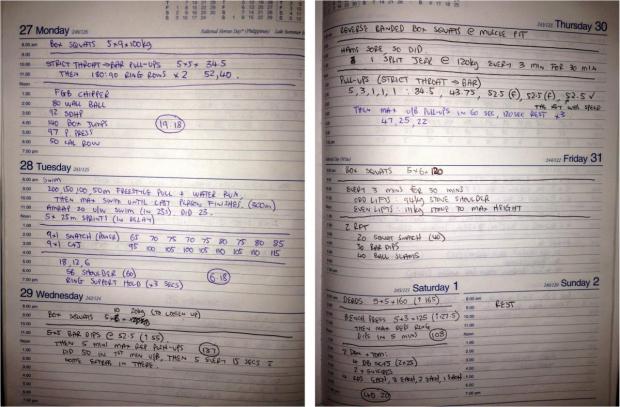
PHASE 2 (to be completed within seven days):

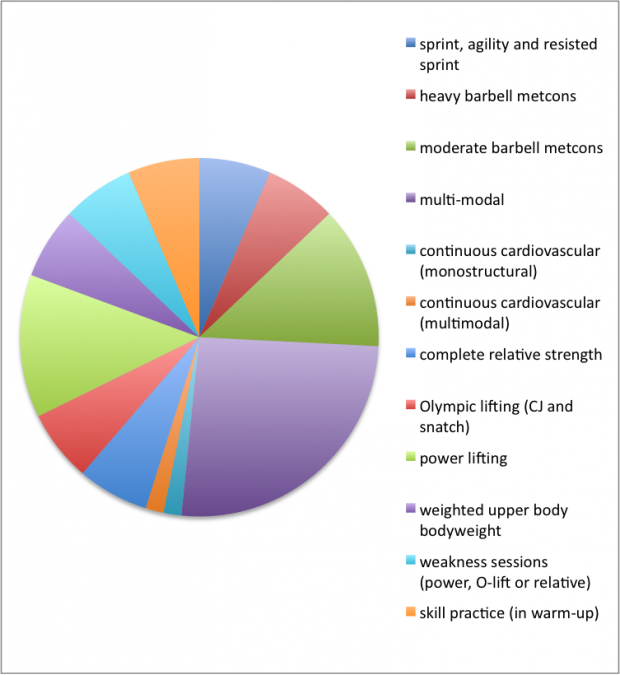
SESSION 1:
A) Power lifting
B) Weighted upper body relative pull
C) Partial relative strength pull
SESSION 2:
A) Heavy Barbell Metcon
SESSION 3:
A) Olympic lifting (clean and jerk and snatch)
B) Multi-modal
SESSION 4:
A) Weakness
B) Multi-modal
SESSION 5:
A) Moderate Barbell Metcon
SESSION 6:
A) O-lifting drills
B) Complete relative strength
SESSION 7:
A) Power lifting
B) Weighted upper body relative pull
C) Partial relative strength pull
SESSION 8:
A) Heavy Barbell Metcon
SESSION 9:
A) Olympic lifting (clean and jerk and snatch)
B) Multi-modal
SESSION 10:
A) Gymnastics practice
B) Interval running
SESSION 11:
A) Sprint, agility, resisted sprint
SESSION 12:
A) Swim (every second week)
OR
A) Continuous cardiovascular (monostructural) / work capacity monostructural (2 x / month ie: one of each type per month).
Sample week:

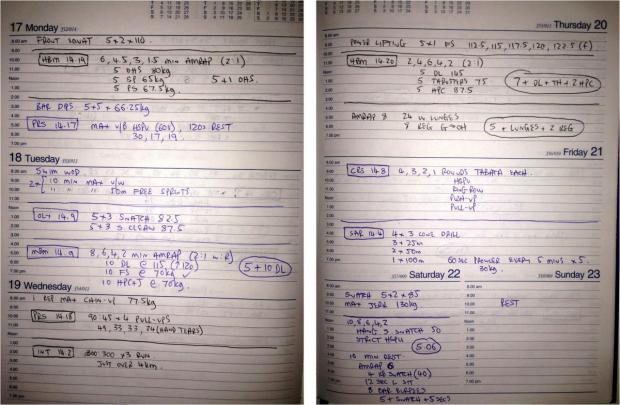
PHASE 3 (to be completed within seven days):

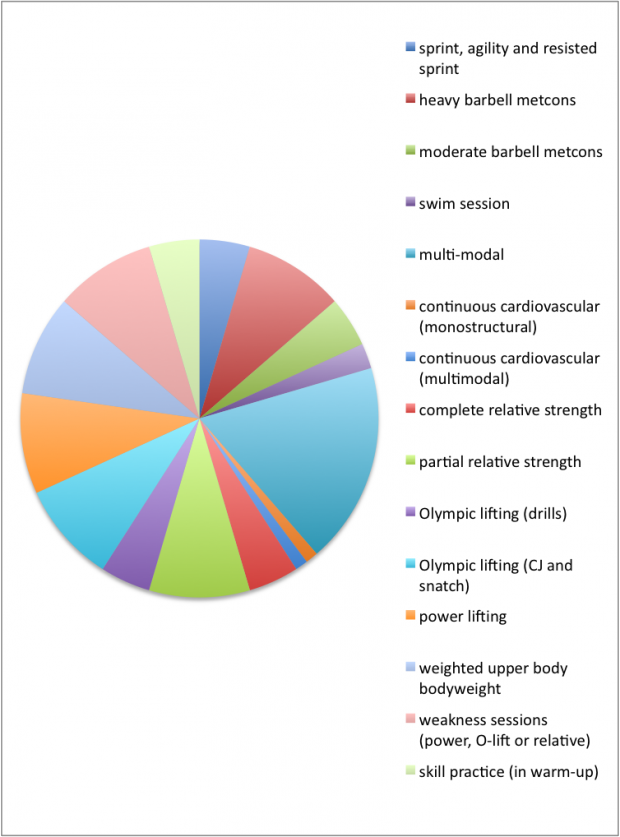
SESSION 1:
A) Moderate Barbell Metcon
SESSION 2:
A) Complete relative strength.
SESSION 3:
A) Multi-modal
SESSION 4:
A) Olympic lifting (clean and jerk and snatch)
B) Multi-modal
SESSION 5:
A) Ping-pong metcon
SESSION 6:
A) Multi-modal
SESSION 7:
A) Multi-modal
SESSION 8:
A) Multi-modal
SESSION 9:
A) Multi-modal
SESSION 10:
A) Ping-pong metcon
SESSION 11:
A) Heavy Barbell Metcon
SESSION 12:
A) Multi-modal
SESSION 13:
A) Multi-modal
SESSION 14:
A) Ping-pong metcon
Sample Week:

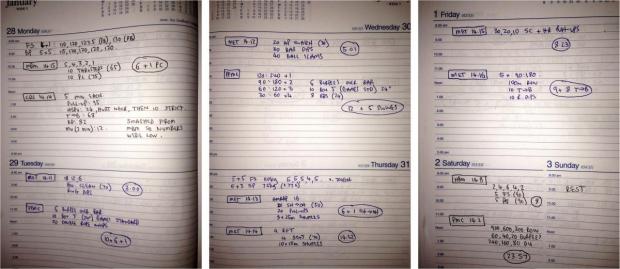
DURING CROSSFIT OPEN:
Followed The CrossFit Open. Strategies.
Monday:
Heavy barbell Metcon
Complete relative stamina
Ping pong metcon
Tuesday:
Olympic Lifting
Multi-modal
Multi-modal
Wednesday:
Rest day
Thursday:
am:
Complete CF Open Workout.
pm:
Heavy barbell metcon
Multi-modal
Friday:
am:
Multi-modal
pm:
Practice any skill based movements in this week’s WODs, but not to the point of fatigue or soreness.
Saturday:
Rest Day and workout specific mobility
Sunday:
Complete CF Open Workout.
Ping-pong metcon
PRE- REGIONALS WORKOUT RELEASE (to be completed within seven days):
SESSION 1:
Heavy Barbell Metcon
10 min rest then:
Running Intervals
SESSION 2:
Multi-modal (no barbell, advanced movements)
Rest five minutes
Partial relative strength push (advanced versions)
Rest five minutes
Tabata cardiovascular (you choose movement)
SESSION 3:
Olympic lifting
Rest 10 minutes
Ping-pong metcon
Rest five minutes
Partial relative strength pull (advanced versions)
SESSION 4:
Weakness session
Rest five minutes
Multi-modal (no barbell, advanced movements)
Rest five minutes
Tabata cardiovascular (you choose movement)
SESSION 5:
Multi-modal (no barbell, advanced movements)
Rest five minutes
Tabata cardiovascular (you choose movement)
SESSION 6:
Multi-modal (no barbell, advanced movements)
Rest five minutes
Tabata cardiovascular (you choose movement)
SESSION 7:
Ping-pong metcon
SESSION 8:
Heavy barbell metcon
10 min rest then:
Running Intervals
SESSION 9:
Multi-modal (no barbell, advanced movements)
Rest five minutes
Partial relative strength push (advanced versions)
Rest five minutes
Tabata cardiovascular (you choose movement)
SESSION 10:
Olympic lifting
Rest ten minutes
Ping-pong metcon
Rest five minutes
Partial relative strength pull (advanced versions)
SESSION 11:
Multi-modal (no barbell, advanced movements)
Rest five minutes
Tabata cardiovascular (you choose movement)
SESSION 12:
Weakness session
Rest 10 minutes.
Moderate Barbell Metcon
SESSION 13:
Multi-modal (no barbell, advanced movements)
Rest five minutes
Tabata cardiovascular (you choose movement)
POST- REGIONALS WORKOUT RELEASE (Complete two sessions / day):
For all Regionals events I determined the limiting factor for me, and the training reflects this limitation.
- Jackie with fast paced row (1.40/500m)
- 30 burpee muscle-ups for time
- 50 wall ball, 100 chest to bar pull-ups
- 5 x 3 OHS from ground at opening weight (100). Rest 3 mins between sets.
Rest 30 mins
21, 15, 9 deads and BJ - Event 6
- Event 7
- Jackie with row @ 5s/500m under fast pace (no pull-ups) (1.45 pace)
Rest 5 mins
Tabata dumbbell snatch (30) - Event 2 (OHS)
2 min rest
EMOTM 21: 4/3 burpee muscle-ups (mins 1, 4, 7, 10, 13, 16, 19), 15 toes to bar (mins 2, 5, 8, 11, 14, 17, 20), 15/10 HSPU (mins 3, 6, 9, 12, 15, 18, 21). - 100 chest to bar pull-ups, 100 pistols
- Half reps of event 6 (chipper), but full distance walking lunge.
- Every 2 mins for 10 mins, 1 rope climb and 4 squat cleans (100/60)
- Jackie with row @ 10s/500m under fast pace (no pull-ups)
Rest 5 mins
Tabata dumbbell snatch - Event 2 (OHS)
2 min rest
EMOTM 21: 4/3 burpee muscle-ups (mins 1, 4, 7, 10, 13, 16, 19), 15 toes to bar (mins 2, 5, 8, 11, 14, 17, 20), 15/10 HSPU (mins 3, 6, 9, 12, 15, 18, 21). - 100 pistols, 100 DB snatches
- Warm up to 1×3 OHS from ground at opening weight.
5 mins rest
100 chest to bar pull-ups - 9, 6, 3 deads and BJ
- Half reps of event 6 (chipper), but full distance walking lunge.
- Event 7 (rope/SC)
Followed the guidelines discussed in Pre- Competition Tapering.
Sprint, agility and resisted sprint work: 25, 50, 100m sprints. 400m sprints. Sled/prowler/hill sprints. Very long rest for all. Focus is speed not cardiorespiratory endurance.
Heavy barbell metcons (80% 1RM). 5, 3, 1 for two or three movements. 3 x 5 min AMRAPs with 2 mins rest after each. Or 5, 4, 3, 2, 1 min AMRAPs with 2:1 work to rest ratio.
Moderate barbell metcons (60% 1RM). 10 reps each movement. 3 x 5 min AMRAPs with 2 mins rest after each. Or 5, 4, 3, 2, 1 min AMRAPs with 2:1 work to rest ratio.
Ping pong metcons: Short fast sets of cardiorespiratory limited movements. Mixture of phosphocreatine, glycolytic and oxidative time domains. (add in light olympic lifts and their progeny @ 25% 1RM).
Swim WOD: Interval based swimming, sprint work, short rest and hypoxic work.
Multimodal: (Metcons with multiple elements with novelty exercise alternatives to increase neuromuscular training. Ideally novelty versions of the workouts programmed by the person/s programming the competition you’re training for). These sessions should send you to the canvas from a cardiovascular point of view but should not make you sore or interfere with whatever training bias of that phase (if not C-R endurance). Complete wearing a weighted vest where appropriate.
Continuous cardiovascular (monostructural): Long run/swim/cycle/row for 30 mins.
Continuous cardiovascular (multimodal): Ping pong metcon with five exercises AMRAP in 30 mins.
Complete Relative strength: 4 x 5 min AMRAPs of bodyweight stamina work, followed by muscle-ups and Tabata bodyweight legs.
Partial relative strength: Push (push-up/ring dip/HSPU) or pull (pull-up) based relative strength to follow weighted relative strength session.
Olympic lifting (drills): Olympic lifting drills specific to the individual (need a list of common weightlifting faults and the corrective drills to fix them). Also use this session for speed production – lower weight but very fast (need to find the ideal weight for power production from the blog I wrote on the topic).
Olympic lifting (clean and jerk and snatch): Five sets of 3/2/1 of clean and jerk and snatch for heavy loads.
Power lifting: 5×5, 5×3, 5/3/1/1/1 reps of deads, back squat, strict press/bench.
Weighted upper body bodyweight: 5×5, 5×3, 5/3/1/1/1 reps of weighted bar dips, throat to bar pull-ups.
Interval cardiovascular: Run or row. Mixture of phosphocreatine, glycolytic and oxidative time domains.
Weakness sessions: Added in to create bias. Should be occurring 2/3 times per week (not sure which one) on top of standard programming. Weakness sessions will occur if the weakness is not already being addressed three times / week (ie: if it’s being addressed twice a week, add in one weakness session, if not at all, add in three weakness sessions). Should be a trainable, not practicable element (power lifting, O lifting or relative strength).
Skill Practice: 3 x 5 minute bouts of unstructured low intensity skill practice (not training).
I’ve spent countless hundreds of hours programming for CrossFit over the last six years. Perhaps foolishly, I decided some time ago that I would program individually for my athletes. With a small number of clients this was fine. As Range of Motion grew this became a bigger task. I began to work with remote clients from around Australia and the time requirements grew. I’ve always been big on systems – maximising the efficiency of a task by creating pre-determined flow. After much work, my entire programming skill and knowledge has gone into developing My Fitness File.
My Fitness File examines measures of an athlete’s fitness, develops a custom profile, and prescribes a complete exercise program based on the individual’s needs.
More details at www.myfitnessfile.com or through MFF’s Facebook page.

